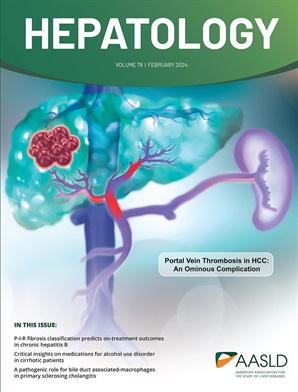使用2017年3月至2020年3月和2021年8月至2023年8月的国家健康与营养调查数据,美国肝脏弹性成像定义的代谢功能障碍相关脂肪变性肝病和纤维化的患病率
IF 12.9
1区 医学
Q1 GASTROENTEROLOGY & HEPATOLOGY
引用次数: 0
摘要
背景,目的:脂肪变性肝病(SLD)是一个重大的公共卫生负担。在此之前,我们在美国通过瞬时弹性成像评估肝脂肪变性和纤维化来估计大流行前SLD的患病率。我们现在估计代谢功能障碍相关脂肪变性肝病(MASLD)的患病率,并检查其与生活方式、社会经济和其他因素的关系。的方法,结果:在2017- 2020年3月和2021年8月- 2023年8月的国家健康与营养检查调查(NHANES)中,对年龄在20岁及以上的13538名非西班牙裔白人、非西班牙裔黑人、非西班牙裔亚洲人和西班牙裔男性和女性的肝脏硬度和控制衰减参数(CAP)进行了评估。SLD (CAP >300 dB/m)的患病率为28.7%,纤维化(肝僵硬>;8 kPa)的患病率为11.3%,MASLD的患病率为25.6%。在两个调查周期之间,年龄标准化SLD患病率无显著差异,MASLD患病率下降(26.8%至23.6%),纤维化患病率上升(10.4%至12.7%)。在多变量调整分析中,MASLD和纤维化与糖尿病、较高的体重指数和腰臀比、血压升高相关,与非西班牙裔黑人种族成负相关。MASLD还与男性、非西班牙裔亚洲人种、糖尿病前期、高总胆固醇、低高密度脂蛋白胆固醇和久坐不动的生活方式有关。纤维化也与SLD、总胆固醇降低和教育程度降低有关。结论:在美国人群中,MASLD和纤维化患病率与肥胖和糖尿病一起很高。我们的研究结果表明,早期发现慢性肝病并针对生活方式和其他可改变的危险因素可能会减缓疾病向晚期纤维化和肝硬化的进展。本文章由计算机程序翻译,如有差异,请以英文原文为准。
Prevalence of metabolic dysfunction-associated steatotic liver disease and fibrosis defined by liver elastography in the United States using National Health and Nutrition examination survey 2017-march 2020 and august 2021-august 2023 data
Background & Aims: Steatotic liver disease (SLD) is a significant public health burden. Previously, we estimated prepandemic SLD prevalence determined by transient elastography assessed hepatic steatosis and fibrosis in the United States. We now estimate prevalence of metabolic dysfunction-associated steatotic liver disease (MASLD) and examine associations with lifestyle, socioeconomic, and other factors. Approach & Results: Liver stiffness and controlled attenuation parameter (CAP) were assessed on 13,538 non-Hispanic White, non-Hispanic Black, non-Hispanic Asian, and Hispanic men and women aged 20 years and over in the National Health and Nutrition Examination Survey (NHANES) 2017-March 2020 and August 2021-August 2023. The prevalence of SLD (CAP >300 dB/m) was 28.7%, of fibrosis (liver stiffness >8 kPa) was 11.3%, and of MASLD was 25.6%. Between the two survey cycles the age standardized SLD prevalence was not significantly different, MASLD prevalence decreased (26.8% to 23.6%), and fibrosis prevalence increased (10.4% to 12.7%). In multivariable-adjusted analysis, both MASLD and fibrosis were associated with diabetes, higher body mass index and waist-to-hip ratio, elevated blood pressure, and inversely associated with non-Hispanic Black race-ethnicity. MASLD was also associated with male sex, non-Hispanic Asian race-ethnicity, pre-diabetes, higher total cholesterol, lower HDL cholesterol, and greater sedentary lifestyle. Fibrosis was also associated with SLD, lower total cholesterol, and less education. Conclusions: In the U.S. population, MASLD and fibrosis prevalence are high along with obesity and diabetes. Our findings suggest that early detection of chronic liver disease and targeting lifestyle and other modifiable risk factors may slow disease progression toward advanced fibrosis and cirrhosis.
求助全文
通过发布文献求助,成功后即可免费获取论文全文。
去求助
来源期刊

Hepatology
医学-胃肠肝病学
CiteScore
27.50
自引率
3.70%
发文量
609
审稿时长
1 months
期刊介绍:
HEPATOLOGY is recognized as the leading publication in the field of liver disease. It features original, peer-reviewed articles covering various aspects of liver structure, function, and disease. The journal's distinguished Editorial Board carefully selects the best articles each month, focusing on topics including immunology, chronic hepatitis, viral hepatitis, cirrhosis, genetic and metabolic liver diseases, liver cancer, and drug metabolism.
 求助内容:
求助内容: 应助结果提醒方式:
应助结果提醒方式:


